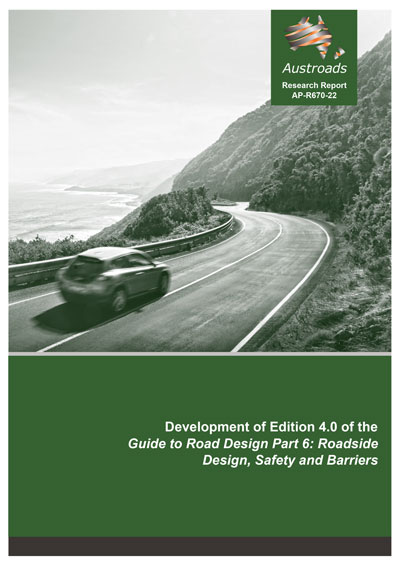Road Design

Development of Edition 4.0 of the Guide to Road Design Part 6: Roadside Design, Safety and Barriers
- Publication no: AP-R670-22
- ISBN: 978-1-922700-39-1
- Published: 7 June 2022
- PDF (free) Download
This research report documents changes to Edition 3.2 of the Austroads Guide to Road Design Part 6: Roadside Design, Safety and Barriers, and in particular, Sections 4, 5 and 6. This research report also provides background information to the guidance and commentary which informs the reader on aspects of the Guide.
The topics covered include the flexibility of barriers, working width, a barrier’s points of redirection, the offset of barriers from kerbs, the length of need, the classification of MASH soils to support safety barrier installations, the orientation of barriers on superelevated roads, barrier selection guidance, aesthetic road safety barriers and the performance of frangible poles and masts.
- Summary
- 1. Introduction
- 1.1 Test and Test Vehicle Descriptors
- 2. Barrier Flexibility
- 2.1 Background
- 2.2 Establishing an Equation to Predict ASI Values
- 2.3 What are Typical Barrier Flexibility Values?
- 2.4 Applying the Formula to Predict ASI Values
- 2.5 Other Comments
- 3. Working Width
- 3.1 Definitions and Measurements
- 3.1.1 Working Width for Freestanding Barriers
- 3.1.2 Working Width for Pinned Barriers
- 3.1.3 Changes in System Width
- 3.2 Working Widths for Concrete Barriers – Zone of Intrusion
- 3.2.1 AASHTO Guidance on the Zone of Intrusion
- 3.2.2 The Alberta Roadside Design Guide
- 3.3 Vehicle Roll Allowance
- 3.4 Barriers with Lighting Columns Attached
- 3.5 Recorded Working Widths
- 3.6 Additional Roll Allowance
- 3.7 Protecting Bridge Piers
- 3.1 Definitions and Measurements
- 4. Points of Redirection
- 4.1 Approach Points of Redirection for Different Terminal and Barrier Types
- 4.1.1 Approach Points of Redirection and Length of Need
- 4.2 Departure Point of Redirection
- 4.2.1 Attributes of the Departure Point of Redirection
- 4.2.2 Tests Near the End of a W-beam Barrier
- 4.2.3 Determining the Departure Point of Redirection
- 4.2.4 The Departure Points of Redirection for Other Barrier Types
- 4.1 Approach Points of Redirection for Different Terminal and Barrier Types
- 5. Vehicles Interacting with Kerbs
- 5.1 The Effect of Kerbs in Front of Stiff W-beam Barriers
- 5.2 The Effect of Kerbs in Front of Wire Rope Barriers
- 5.2.1 Vehicles Interacting with Wire Rope Barriers
- 5.2.2 Application to the Positioning of Kerbs in Front of Wire Rope Barriers
- 5.3 Effect of Different Kerb Profiles
- 5.4 Acceptable Locations for Barriers
- 5.4.1 Acceptable Locations for Non-Proprietary G4 Barriers
- 5.4.2 Acceptable Location for Wire Rope Barriers
- 5.4.3 Acceptable Location for Flexible W-beam Barriers
- 5.5 Recommended Barrier Offsets from Kerbs
- 6. Length of Need and Departure Angles
- 6.1 Length of Need on Straight Roads and Barrier Installations That Are Not Flared
- 6.2 The Background to Run-Out Lengths
- 6.3 Departure Angles
- 6.4 The Angle of Departure Method
- 6.4.1 Departure Angles Reflected in Run-Out Lengths
- 6.5 Including a Departure Angle in a Run-Out Length Method
- 7. Classification of Soils in MASH
- 7.1 Standard Soils in MASH
- 7.2 Soil Testing to Meet AASHTO Standard Soils in MASH
- 7.3 Soil Descriptions
- 7.4 Expected Soil Strength of AASHTO Soils
- 8. Barrier Orientation on Superelevated Roadways
- 9. Comments on Flaring of Barriers and Shy Line Distances
- 10. Comments on Barriers for Heavy Vehicles
- 10.1 Possibility of Breaching a Barrier
- 10.2 Loads on Barriers from Articulated Vehicles
- 11. Comments on Barriers for Motorcyclists
- 11.1 Motorcycle Crashes into Barriers
- 11.2 Road Locations with More Frequent Motorcycle Crash Rates
- 11.3 Testing of Motorcyclist Protection Devices (MPD)
- 12. Comments on Barriers for Pedestrians and Cyclists
- 12.1 Barriers with a Pedestrian or Cycle Path Fence Attached
- 13. Comments on Treatments for Embankments and Drainage Structures
- 13.1 Treatments for Embankments
- 13.2 Treatments for Drains
- 13.3 Treatments for Culverts
- 14. Comments on Barrier Selection Guidance
- 14.1 Choosing an Appropriate Containment Level
- 14.1.1 Recommended Practice
- 14.1 Choosing an Appropriate Containment Level
- 15. Aesthetic Road Safety Barriers
- 15.1 Application to Rock Walls
- 16. Frangible Poles and Masts and the Mass Moment of Inertia
- 16.1 Emergency Beacons
- 16.2 Emergency Call Boxes
- 16.3 Importance of the Height of the Centre of Mass and the Mass Moment of Inertia
- 17. Barriers at Intersections and Property Accesses
- 17.1 Bullnose Treatments for Medians
- 17.2 Barriers at Intersections and Property Accesses
- 18. Major Deletions
- 19. Concluding Remarks
- References
Related publications
Latest Road Design News
